Like many classic gamers, I've recently learned that Tips & Tricks Magazine is closing down. The final issue should be on the shelves right now. For those who don't know, T&T began as an spinoff of Videogames Magazine around a decade ago. What was originally meant as a side project became the main magazine once Videogames folded.
Videogame Magazine began as the great Video Games and Computer Entertainment, which was an offshoot of an Atari Computer magazine called Analog. It was a giant among the prozines, and the only really literate one, aimed at an older market - okay, teenagers who actually got decent grades. Most of the other mags were aimed at the 12-year-olds who sniffed glue all day in their dads' basement.
VG&CE even bragged the largest circulation of the prozines, around 1990 or '91. Their downfall was, oddly enough, the explosive arrival of Street Fighter 2, which seemed to miss the staff entirely. Meanwhile, EGM created the most comprehensive strategy guides ever seen and made a fortune.
In the end, VG&CE suffered falling circulation, until its publisher (cough, Larry Flint Publishing, gag) forced the turn into the annoying and stupid Videogames. So, a pretty tragic ending over all, even though Videogames did plug my zine twice, which led to a freelance job with GamePro and NewType Gaming, so I really shouldn't complain. And they did come out with Tips & Tricks, which was an excellent little mag. And now you know.....(long awkward pause)....the...REST....of the story.
I feel sorry that T&T has folded. I'm amazed that it's survived as long as it had. Wasn't it only supposed to last for one or two issues way back then? It's a testament to the brilliant writing and content of everyone involved.
For me, this was the last link to that videogame past, the era of VG&CE and Electronic Games and the fanzines. I always appreciated the fact that T&T pulled writers from the zine crowd, like Ara Shirinian and Pat Reynolds and, of course, Joe Santulli. I don't think we ever truly achieved our dream of the "professional game fanzine," but Tips & Tricks came the closest.
I also think Bill Kunkel is right on the money as far as Gamefaqs is concerned. It's dominant for one simple reason - it's the only player. Instead of a comprehensive game database, I frequently find something that's half-finished, poorly assembled, and cheaply produced. It's designed like a website from the late '90s, not this decade.
The idea of pdf strategy guides, or at least moving away from the endless scrolling text, is long overdue. Heck, do away with those antiquated faq's anyway. They don't help me nearly as often as they should, and very rarely for anything more than one console cycle in the past.
I do think the prozines, as they've existed for the past decade or so, are doomed to extinction, but that's because of their poor content. Then again, I don't know if a market for a real videogame magazine exists yet. You'd think consumers would be more grown up by now, especially now that games are finally accepted as part of our pop culture. You never have to deal with those insulting "I let my kid play this game" articles in magazines and newspapers anymore.
So why isn't the public being served? Why does it seem like the existing prozines are targeting the same kids who read MAD and Spider-Man comics? It's still far too juvenile, still far too corporate, and still far too obsessed with the hype machine. They're catering to children who obsess about their wish lists to Santa.
Fortunately, the internet provides us with far more options than ever before. I'd prefer to see this as our opportunity. The loss of print isn't always a bad thing. Perhaps this media - games - is better suited to an interactive format like the internet. Games journalism is more commonly pursued, and many of us are still working out the kinks, just as videogames are still fairly young. And the arrival of Virtual Console and Live Arcade (and their peers) will finally bring all of videogaming history together. We won't be forced to deal with what's new, new, NEW!!! We'll have choices, and that's going to have a profound impact on things.
Hmm...now that I think about it, this really is the new golden age of videogames. It's never been better. Now we just need the media to really address it.
My endless thanks to Bill Kunkel and everyone at T&T for their many years of dedication and service. Here's hoping you manage to pay the bills without taking a crummy day job. You know, like me.
Friday, June 29, 2007
Monday, June 18, 2007
VC Catchup
Yeah, I know I'm hopelessly out of date on writing weekly Virtual Console updates, but I do keep telling myself to get back on the ball. Trouble is, quite a lot of these games, well, just aren't very good. Also, I do actually sit down for a spell and play each of them, trying to see where my loyalties lie since I first played them around a hundred years ago. All of which means I'm spending more time on excuses than writing. But, thanks to the tireless efforts of the Digital Press message boarders, I'm caught up on the release schedule since April.
I'm off to Lagoon Theatre to see Satoshi Kon's Paprika. When I come back I'll be sure to post this week's games, and then get caught up on the backlog.
I'm off to Lagoon Theatre to see Satoshi Kon's Paprika. When I come back I'll be sure to post this week's games, and then get caught up on the backlog.
Friday, June 15, 2007
Saturn Bomberman Fight!

You know, it's a funny thing. Had this game carried any other name on the label, it would have been hailed as a minor triumph, a sleeper hit for the Sega Saturn. Too bad there's that Bomberman name on the box.
And too bad that Saturn Bomberman Fight directly follows up the greatest Bomberman game - and quite possibly the greatest multiplayer game - of all time, Saturn Bomberman. Now there's a great way to get drunk with some friends on a spare evening. Bomberman Fight had the unlikable job of following up that act. It certainly didn't help matters that the game was rendered in 3D, entirely with polygons. No, sir; that sort of thing borders on blasphemy. Which probably isn't a good topic when the subject involves bombs.
However, I will say this in Bomberman Fight's defense: it's a much better game than those two crummy titles that wobbled onto the Nintendo 64, and certainly doesn't deserve to be swept under history's tides. It's actually a nice little game, so far as I can tell.
So it probably would've helped Hudson's chances if they spun off the 3D Bomberman games into their own realm; perhaps this would have met with a kinder fate. Then again, I don't know how Fight was received in Japan. Perhaps it was something of a hit after all, and just became lost while Saturn was quickly being served with a Texas Burial.
You're probably wishing I'd get to the point, so here it is. Bomberman Fight is presented with playfields at an isometric angle, kind of like Atari's old arcade game Crystal Castles. Everything is drawn with polygons, which are impressively animated, move fairly quickly, and thankfully retain the iconic quality of the cartoon characters. Since when did the Bomberman cast become so goofy?
All of the game's graphics are fluid and colorful and just ooze quality. It's a late-era Saturn game to the core. Loads and loads and loads of explosions, all of which are fiery and fluid. This game introduces a pair of super-bombs, which will ignite a sizeable chunk of the playfield when detonated. It's a nice display of visual effects, even when you're scrambling to get the hell out of the way of the blast. I've managed to blow myself up this way quite a lot.
One notable addition is a health bar. Now you can withstand several bomb hits before being knocked out of the round. The super-bombs, however, will still kill you in one blow. Also, you have the ability to jump, which is an essential new skill. You see, most of these new arenas are in full 3D. Hills, valleys, buildings, bridges - Hudson really tapped into the deathmatch vibe. It's a nice surprise that (almost) makes up for the small size of these arenas.
All the standard Bomberman rules apply. You know the score by now. At least, you should. What are you doing reading this if you haven't played Bomberman? Oh, be warned - this is only a 4-player game. A serious letdown if you're used to the sheer chaos of 8-player matches on Saturn Bomberman. Whatever. There are so many explosions going on you'll barely notice.
Actually, that is a concern. It really is hard to see just what the heck is going on, amidst all of the bombs and super-sized explosions. The speed of the matches is greatly increased, too. I've had rounds finish in under ten seconds. Seems to me that some of the patented strategy was sacrificed for sheer visceral thrills. You'll have to decide for yourselves whether or not that's important to you.
The one-player story mode is a bit of a surprise this time. It's not there. Instead, you face a collection of computer opponents on the battle arenas, kind of like Quake 3. Would anyone be disappointed? Did anyone really ever play the single-player modes? I have a hard time trying to explain why they ever existed.
So Saturn Bomberman Fight is a much more compact and focused game than its predecessor. I've read a common complaint from other websites, that the game is far too easy. There's probably some truth in that, although the computer had no problem kicking my hide in battle mode. But this is meant as more of an immediate experience, and unlike nearly all the later sequels, there's still an actual sense of quality and competence. I honestly have no idea what happened to the Bomberman series after this point. As far as I can tell, Fight is the last good one ever made.
It's not unlike Dylan's Desire. Good album, very good album. It just came on the heels of Blood on the Tracks, which everyone was convinced was Dylan's masterpiece. Bomberman Fight gets stuck with the same curse. And...sing along, class, you all know the words to this one...we get screwed out of another good Sega Saturn fix.
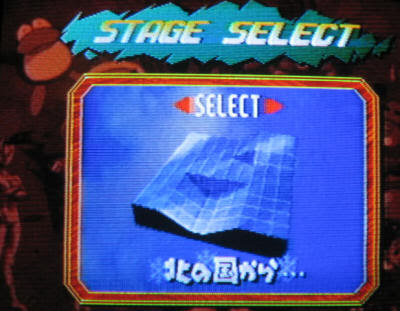
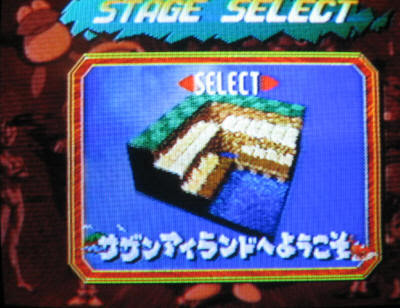
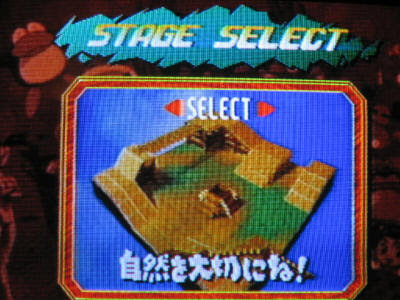
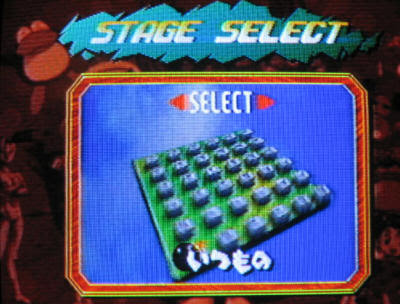



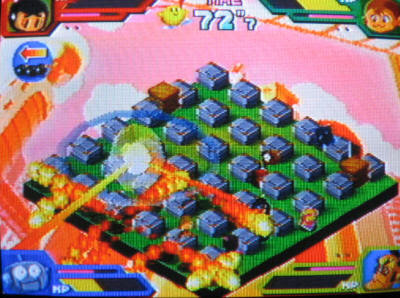



Thursday, June 14, 2007
Virtua Fighter 2 - Today's Tournament Videos
gAnother pair of tourney videos from Japan. VF2 2.0, 5-on-5 teams, lots of intensity and loads of surprises. Check it out, and see if that inspires your own game at all.
Bob Ross - Why I Don't Paint People
Great, catchy little music video tribute to your favorite painter and mine, Bob Ross. Happy trees, happy trees.
Wednesday, June 13, 2007
Nights Retrospective in Edge
Edge Magazine - remember those guys? - recently posted an essay on NiGHTS: Into Dreams on the Next Generation website. It's an excellent read that captures the sheer joy of the game, in anticipation of the upcoming Wii sequel. Give it a read.
Tuesday, June 12, 2007
Virtua Fighter 2 - Today's Tournament Video
There are a number of great Virtua Fighter 2 movies available on YouTube, from a number of the old tournaments from Japan. Chances are, if you're from America, you've never really seen Virtua Fighter the way it was really meant to be played. But for whatever reason, the Japanese kids took Sega's premier franchise to a whole new level.
It goes without saying, but you or I wouldn't stand a snowball's chance in hell against any of these guys. But it's great fun to watch. I think VF is the only series of fighting games that's just as exciting to watch as it is to play. Most likely it's due to the extreme skill the game requires, far more than most of us expect from an arcade brawl. It still hasn't been surpassed, really; even if the complexity and depth have left everyone outside of Japan hopelessly lost.
Anyway, here are two videos from the 5th Athena Cup Team Battle Tourney. Lots of heavy competition all around, some thrilling comebacks, and a couple upsets. I think I'll post one of these every day, just to spread things about. Hope this spurs you to pull out your Saturns.
It goes without saying, but you or I wouldn't stand a snowball's chance in hell against any of these guys. But it's great fun to watch. I think VF is the only series of fighting games that's just as exciting to watch as it is to play. Most likely it's due to the extreme skill the game requires, far more than most of us expect from an arcade brawl. It still hasn't been surpassed, really; even if the complexity and depth have left everyone outside of Japan hopelessly lost.
Anyway, here are two videos from the 5th Athena Cup Team Battle Tourney. Lots of heavy competition all around, some thrilling comebacks, and a couple upsets. I think I'll post one of these every day, just to spread things about. Hope this spurs you to pull out your Saturns.
Saturn Deep Fear - Gameplay Movies
Once again, thank heavens for YouTube. Now why the heck can't I upload anything to their site? What the hell did I do to my computer?!
Deep Fear - Screens and First Impressions
 One of my latest Saturn downloads is this late-era title from Sega themselves, a survival horror games called Deep Fear. It was released in Japan in 1998 and was ported to Europe, where it earned the notable prestige of being their final Saturn release.
One of my latest Saturn downloads is this late-era title from Sega themselves, a survival horror games called Deep Fear. It was released in Japan in 1998 and was ported to Europe, where it earned the notable prestige of being their final Saturn release.Again, I don't want to sound like a broken record, since this refrain always keeps coming back. But why the hell didn't Sega of America bother with this game? A spooky, atmospheric game, ripped right off of Resident Evil...what exactly was the problem? Among videogamers, there are are few business suits who have become whipping boys for Whatever Went Wrong. The Tramiel family that owned Atari Corp (and oversaw the Atari 7800, Lynx, and Jaguar) are one example.
I'd say Bernie Stolar fits as a candidate. Here was the man in charge of Sega America, and handling the Sega console in the States. He infamously declared that 2D was out, that anything overtly Japanese was out - 3D was the wave of the future. Aggressive, macho, comic book types were the future. All of which really meant one thing - Playstation was the future. So, instead of presenting Saturn as a true alternative console, playing to its unique strengths, we were subjected to mediocre ports and lackluster attempts at 3D graphics from programmers who really weren't all that good. Saturn quickly established a reputation as a second-hand system, one that couldn't handle 3D, and the console race was practically finished at the starting line.
And across the ocean, back in Japan, lay entire warehouses full of top-quality games, games that pushed 2D graphics further than ever before, and games with 3D polygons that embarassed most of the Western studios. The console was a beast, a struggle to learn, yes. No denying that. But for those who possessed the skills and patience, Saturn paid some remarkable dividends.
Which brings us back to Deep Fear and Stolar's inability to know a good videogame when he saw it. Well, Deep Fear was released in 1998, the same year SOA's dear leader learned about the company's Dreamcast project. And like the smart businessman he was, he immediately scuttled Saturn in the US. And then he learned that Dreamcast was more than a year away from release.
I understand the man's working for Sony now. Interesting.
I've just started playing, so there isn't much I can contribute at this point, other than to say this is a game with real quality. The late-era Saturn games are among the best in the library, which only demonstrates that the system's greatest weakness was its learning curve. I can offer these screenshots, which should give you a good idea of what to expect.







Monday, June 11, 2007
Pastel Muses
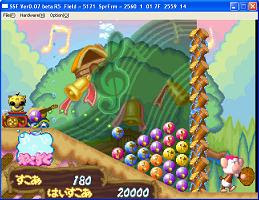
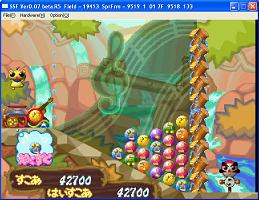
Heaven only knows how many cheap Bubble Bobble knock-offs there are, but here's one that just different enough to be good. It's called Pastel Muses, and was released for Sega Saturn in Japan. The gimmick is pretty simple enough; it turns Bubble Bobble on its side and requires you to lob colored balls across the field.
I probably wouldn't be impressed if it weren't for the fact that you have to gauge trajectory and power when making your shots. It's evidence that the designers actually put some thought into the formula, instead of replacing one set of cartoon characters for another. You are helped out with that familiar dotted line on the first round, but after that, you're on your own.
I haven't spend enough time with the game to check out all the game modes, aside from the main story mode. Each level contains several stages, followed by a boss battle. The trick is that you aren't competing in seperate vaults, like every other puzzler. No, this time the boss character actually stands in between you and the jewels in the pit. You need to know how to fire above him; it he gets hit he'll march forward. Nice.
Pastel Muses offers a lot of bright, chirpy 2D graphics, the kind you expect to see on a Saturn. Nothing exceptional, but nice, and nobody ever expects much from a puzzle game, anyway. There seems to be a lot of stages and characters to discover, and there's a fair bit of challenge. I'm frankly surprised that nobody has bothered with the sideways approach yet. Why is every Tetris puzzler set in the same vertical pit? Would it kill them to do something different for a change?
So Pastel Muses is a pretty fun game. Would have been nice to see it released in the States, but that's another tired refrain that gets used too much. Give it a try sometime and see what it does for you.
UPDATE: Wouldn't you know it, there's a gameplay clip on YouTube. Enjoy!
Sunday, June 10, 2007
Goiken Muyou 2 - PS2 Screens
Shows what can happen with a little patience on the internets. Found a site that posted screenshots from the PS2 sequel to my new favorite Saturn brawler. I've even seen a couple gameplay movies posted on YouTube. I've never heard of this game until now, obviouly, so I can't comment on what it's like.
That said, this game doesn't look as impressive to me as original. I'm not too sure of the reasons why, whether I've never been a fan of that heavily-shaded "Playstation look," or if the polygon graphics of a decade ago appeal more to me on an iconic level. Can't really say why. All I know is that the graphics to GM2 don't look all that good. You tell me - am I wrong to believe the graphics are worse than on the Saturn?
Another thing that strikes me - the characters look generic. They've become the same copycats as everyone else. That punk style of Anarchy really appeals to me. I like the idea of a fighting game culled from some schmoes off the street, and a group of professional game players. How do you beat a middle-aged ballerina and a disco-dancing businessman? I don't think this kind of game can have a sequel. Not everything is meant to be branched off into an endless franchise. Sometimes it's better to get your kicks and leave it at that.
If you don't understand what I mean, just wait a few years when "Shrek 5," comes out.
Anyway, some Goiken Muyou 2 screens - dig in.
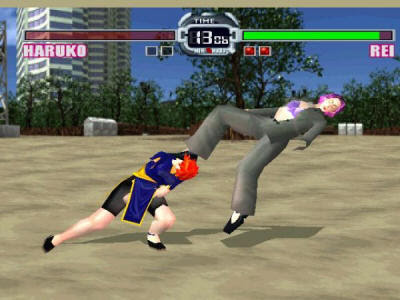
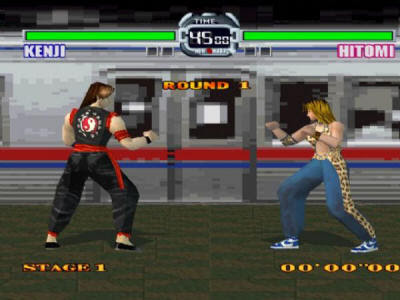
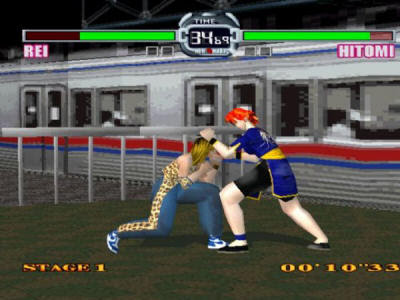
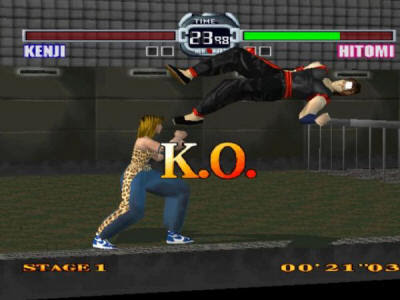
That said, this game doesn't look as impressive to me as original. I'm not too sure of the reasons why, whether I've never been a fan of that heavily-shaded "Playstation look," or if the polygon graphics of a decade ago appeal more to me on an iconic level. Can't really say why. All I know is that the graphics to GM2 don't look all that good. You tell me - am I wrong to believe the graphics are worse than on the Saturn?
Another thing that strikes me - the characters look generic. They've become the same copycats as everyone else. That punk style of Anarchy really appeals to me. I like the idea of a fighting game culled from some schmoes off the street, and a group of professional game players. How do you beat a middle-aged ballerina and a disco-dancing businessman? I don't think this kind of game can have a sequel. Not everything is meant to be branched off into an endless franchise. Sometimes it's better to get your kicks and leave it at that.
If you don't understand what I mean, just wait a few years when "Shrek 5," comes out.
Anyway, some Goiken Muyou 2 screens - dig in.




Anarchy Video Review
Retro Core Vol. 5 - click to watch
Found a nice video review program called Retro Core, from across the pond, I'm assuming. It's a show devoted to the classic games and systems, and starts things off with a look at Goiken Muyou: Anarchy in the Nippon. It's a great opportunity to see the game in action, even though the video is rather small.
Also, I've discovered the names of the Virtua Fighter Iron Men (Tetsujin) who played a part in the making of Anarchy and appeared as bonus characters. Their names, as I've said, correlate to their preferred VF player. I've also discovered while playing that most of their moves are actually taken from VF3, with a mixture of the other Anarchy players for good measure.
Ikekuburo Sarah, Shinjuku Jacky, Bunbun Maru, and Kashiwa Jeffrey are their names, in case you're wondering. If you're a VF fan and scour the internet for old fighting tourney clips, you may have heard of them.
Found a nice video review program called Retro Core, from across the pond, I'm assuming. It's a show devoted to the classic games and systems, and starts things off with a look at Goiken Muyou: Anarchy in the Nippon. It's a great opportunity to see the game in action, even though the video is rather small.
Also, I've discovered the names of the Virtua Fighter Iron Men (Tetsujin) who played a part in the making of Anarchy and appeared as bonus characters. Their names, as I've said, correlate to their preferred VF player. I've also discovered while playing that most of their moves are actually taken from VF3, with a mixture of the other Anarchy players for good measure.
Ikekuburo Sarah, Shinjuku Jacky, Bunbun Maru, and Kashiwa Jeffrey are their names, in case you're wondering. If you're a VF fan and scour the internet for old fighting tourney clips, you may have heard of them.
Saturday, June 09, 2007
Anarchy in the Nippon - Saturn's Best Brawler?
 Right now you're probably wondering just what this game is. Certainly looks interesting, but what the heck is it? It's name is Goiken Muyou: Anarchy in the Nippon. You've almost certainly never heard of it before, but this may be the best polygon fighter ever made for Sega Saturn.
Right now you're probably wondering just what this game is. Certainly looks interesting, but what the heck is it? It's name is Goiken Muyou: Anarchy in the Nippon. You've almost certainly never heard of it before, but this may be the best polygon fighter ever made for Sega Saturn.The story, according to Segagaga Domain, goes something like this: after Sega completed the excellent Saturn conversion of Virtua Fighter 2, a number of AM2 programmers wanted to immediately follow up with another fighting game. Sega declined, for unknown reasons, perhaps because they didn't want to take any attention away from VF2, which quickly gave Saturn a second chance at life.
Eventually, four members of the AM2 team broke away and started their own little group to make their dream game. The end result was Anarchy in the Nippon, published by KSS in 1997.
The title is very appropriate, actually. This plays out more like a punk tribute/parody to the Virtua Fighter series. These guys were clearly great fans, and they imbued their game with a breezy irreverence and loose humor. In terms of the gameplay, it's Virtua Fighter down to its core; there's a lot of VF3 in the mix, like the use of a dodge button. But it's also a little like Tekken, with its fast, breezy action and opn-ground environments. Only one rooftop stage features a small fence at the perimeter, and I've yet to discover if one can be knocked off the roof. Aside from that, no ring-outs.
Fighting games have long since settled on a rigid, archetypal character list, nearly always copying one another. This is one of those punk traits in Anarchy - the game characters look just like ordinary people off the street. You can see them from the screenshots, and it's a pretty goofy mix. Most have a street-edge quality to them, like a skatepunk kid and the different girls. The favorites, of course, will include a middle-aged woman who dresses in outrageous color and fights the ballet, and a middle-aged salaryman, whose moves include spinning, running, fainting, and - I swear I'm not making this up - running under the opponent's legs and poking them in the butt.
The best inclusion - and this is where you really have to be a VF nut - are four real-life VF tournament players. I did a double take when I recognized the name Bun Bun Maru, and likewise with the other three, who are named after the VF fighters they specialized in. How's that for a kick? I'll suspect that these four likewise had a hand in the game's construction, since it's so damned precise and smooth.
It's also a great tribute to this game that the VF pros each inhabit their own fighting styles. No Mortal Kombat palette swaps in sight. Thank goodness. I don't know if this game was ever a hit in Japan, but you'd expect them to brag about it for a long time.
If there ever was a game that deserves to be called "Virtua Fighter Remix," it's this one. This isn't to say that all of the moves are cut and pasted from Sega; instead, it's the feel of the original that has been planted, the style of Jacky and Wolf and Akira and Shun-Di. A lot of familiar moves, and a lot of different moves, but not without any sense of seriousness or gravity. There isn't the burden of upholding the tradition of Sega's most profitable arcade franchise. It's all fun and games, like hearing your favorite band make noise in a basement dive for kicks.
Visually, Anarchy is a fantastic game. Large characters, 60fps, terrific texture and color, impressive environments, and all in Saturn's glorious hi-res mode. It's clearly a step above VF2, which has always been the benchmark of what Saturn could do. Interesting, isn't it, that Sega never really could match that achievement, not with Fighting Vipers, nor with Fighters Megamix. I'd say Last Bronx comes the closest, and may actually surpass VF2 with its brilliant use of faking a 3D environment. But I haven't spent enough time with that one yet, and it came near the end of Saturn's life here in America. Perhaps Anarchy would have met the same fate.
So I think, in terms of the graphics, Anarchy in the Nippon is the best 3D brawler for the Saturn. In terms of the gameplay, it's easily the match of any of 'em. I might like this one a bit more, if just because of its irreverence and that office worker guy.
Gameplay modes are tricky to figure out, because nearly all the text is in kanji, but in addition to the one- and two-player modes, there's the team battle, a watch mode, a practice mode (complete with moves list), and a character-create mode where you pick one of the fighters, assemble your own stats, and put 'em in action. It's just like the famed Kumite mode from VF4 - perhaps these programmers returned to Sega in the end?
How obscure is this game? Other than Segagaga Domain - a godsend for any Saturn fan - I found a review on one other site, in French. That's it. I do see that KSS published a sequel for the Playstation 2, but I know absolutely nothing about it. The box art on the back suggests that the sequel takes itself more seriously, and maybe it's meant to be a fighting game to stand on its own, instead of the Husker Du tribute the original is. I guess someone will just have to import the damned thing and find out.
So here you go - another one of the great "lost" Saturn classics that deserves a place alongside Radiant Silvergun, Soukyugurentai, Grandia, Cotton Boomerang, and Street Fighter Zero 3. Again, you wonder what would have happened if kids wandering the American malls would have done if they walked into the game store...and saw this.
Anarchy in the Nippon - Shots 3
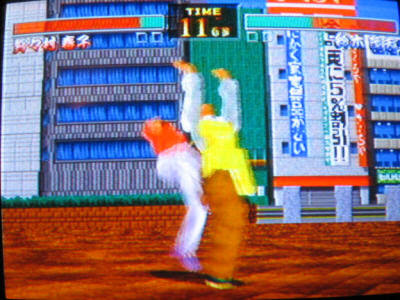
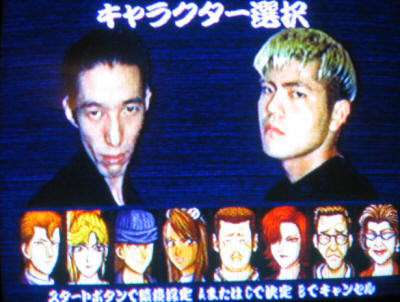
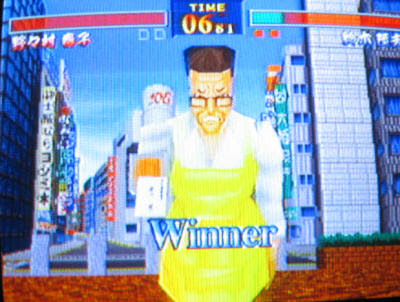
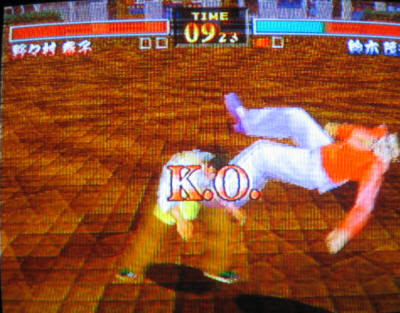
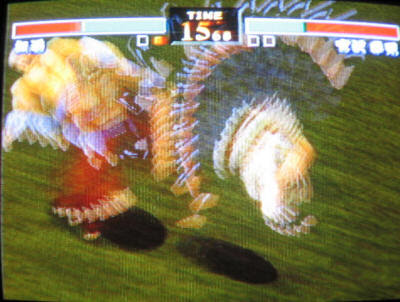
The third set of screenshots for Anarchy in the Nippon. These are all of them for now, though I may go back and snap more pictures. I've also recorded video clips, but I can't seem to upload videos from my computer for some reason. Downloading is fine, I just can't upload.
Oh, and in case you can't tell, I'm a big fan of this game. Definitely one of the best of the "lost" Saturn games.
Anarchy in the Nippon - Shots 1
Thursday, June 07, 2007
Photos - Shienryu on Sega Saturn
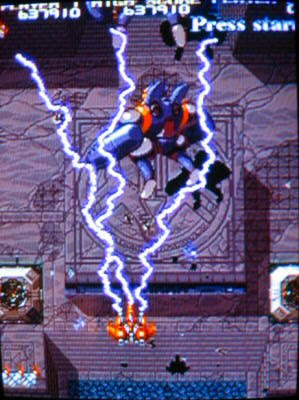
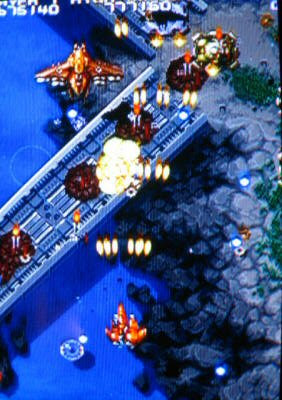
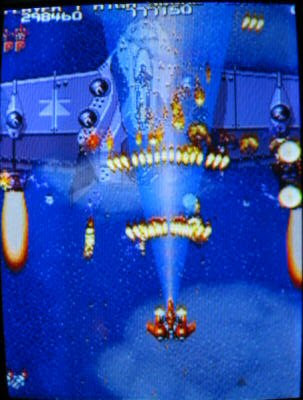
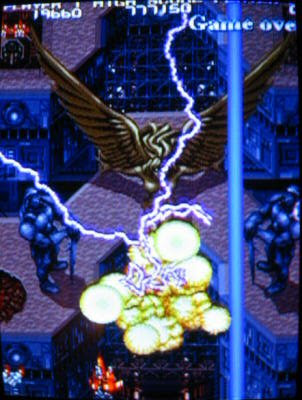
Shienryu was one of the earlier arcade shmups to appear on Saturn. I first heard of this title from Next Generation, which dismissed the game as warmed-over leftovers in a tepid three-star review. Then again, they were nearly always dismissive of any traditional 2D games. Let's face it: Next Gen's writers were technology nerds. We didn't mind at the time, since, hey, it was a thrill just to read some actual criticism in a prozine.
Well, that's out of the way, and the era has long since past. We can enjoy things on a more balanced level, without any of the silly politicking. And despite any prejudices you may carry, this is a really fun game, more so than I expected.
Shienryu appeared in arcades on Sega's ST-V system, which was a beefed-up Saturn and used fairly extensively during the 32-bit days. The game is standard fare for the overhead, vertically scrolling shooter, with endless waves of flying saucers, rolling tanks, and ever-increasing mother ships and bosses to dispatch. Three weapons are available, all cliched and not very inventive. There's the usual bullet spread shot, a concentrated electric beam that hones in on targets, and bursts of rockets. Of these, the rockets are my least favorite. Maybe it's because they fire so infrequently, or maybe because they don't go boom the way I like. Maybe it's just because they're colored yellow. I don't know why; I'm just not fond of shmup powerups that are yellow. Twin Cobra comes to mind - maybe that's the culprit.
You know what I miss? That flamethrower from Fire Shark. That was inspired. Why are we always relying on the same weapons, game in, game out? You're playing out the oldest genre of videogames. Show up with one idea that's actually your own.
This game gets compared to Raiden a lot, and it's easy to see that in the graphics, especially the way everything explodes in tiny shards of debris. I enjoy watching details like that; I'm mindful of how taxing on the animation things like this require, and it's always the first thing to be cut from the home versions. Saturn finally enabled arcade-perfect shmups, with all that extra sugarcoating.
There's also the way the alien worlds are integrated in later levels, the way tanks and ships move around arranged corridors, moving about their business, instead of merely flailing at you in endless suicide bursts. I think it's a key detail of good shooters from the '80s and '90s, one of those things Toaplan did better than anyone else.
So it turns out that Shienryu has some charms after all. Certainly not perfect, and it's easily overshadowed by the flashier, brasher Saturn shmups. A little weird, really. This game offers most of the same bells and whistles as the others, save those show-offs at the top of the class, the ones named Silvergun, Sokie, Garegga and Cotton B. That's what happens when you pack too many student into the same classroom.
Shienryu features the same screen layout options as all of its peers on Saturn. You can play normally with a scaled-down screen (to fit onto your televisions), or turned on its side in full glory. That's always the better option, especially for showing off, or those times when you're just too damned tired to get up. Not bad for an arcade game that wasn't worth more than five bucks at Aladdin's Castle.
Subscribe to:
Comments (Atom)















